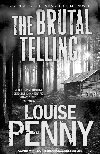
The Brutal Telling
Louise Penny
Hodder Headline
$24.95
paper
374pp
978-0-7553-4104-7
On a more mundane plane, the story begins when the body of an unknown old man is found in Olivier and Gabri’s Bistro, at the heart of the village of Three Pines. Chief Inspector Gamache and his team are called in and the narrative moves along briskly, with great characters and all of Penny’s usual charm, wit, and ebullience – until about the halfway point. Then, just when you have been hoping it would never end…well, be careful what you wish for.
Several possible culprits are produced, each with tantalising but unconnected backstories. Numerous unlikely clues also appear, including a cabin full of priceless art treasures, some of which are linked to the name Charlotte; a code called Caesar’s Shift; and the word “WOO,” which was the name of Emily Carr’s monkey, as well as being a variant of “woo-woo,” a British slang word which, according to Google, “refers to ideas considered irrational or based on extremely flimsy evidence or that appeal to mysterious occult forces or powers.”
All this makes perfect sense to Chief Inspector Gamache, who hares off to the Queen Charlotte Islands to inspect Haida totem poles before returning to rural Quebec to make his arrest.
We could wish that Penny’s team of editors and advisors had been a little more brutal as regards the plotting of this one. But as with all Penny’s books, it remains an enjoyable read. mRb






0 Comments